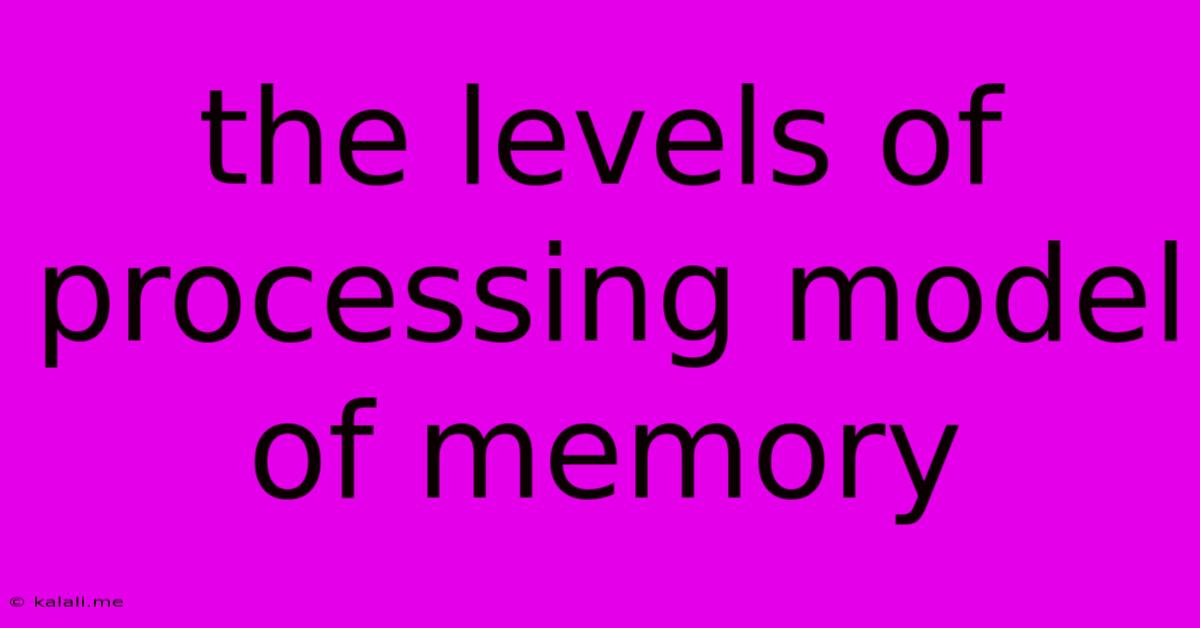The Levels Of Processing Model Of Memory
Kalali
Jun 15, 2025 · 3 min read

Table of Contents
The Levels of Processing Model of Memory: A Deep Dive
Meta Description: Understanding how memory works is crucial for effective learning and recall. This article delves into the Levels of Processing model, explaining its principles, strengths, weaknesses, and real-world applications. Learn how encoding depth impacts memory retention!
The human memory is a fascinating and complex system, capable of storing vast amounts of information. One influential model that attempts to explain how we process and retain this information is the Levels of Processing Model of Memory. This model, proposed by Fergus Craik and Robert Lockhart in 1972, suggests that the depth of processing during encoding significantly influences the strength and duration of memory traces. Instead of focusing on separate memory stores (like sensory, short-term, and long-term memory), it emphasizes the process of encoding itself as the primary determinant of memory success.
The Core Principle: Depth of Processing
The Levels of Processing model postulates that memory is not a unitary system but rather a continuum. The deeper the level of processing, the stronger and more durable the memory trace. This "depth" refers to the degree to which incoming information is analyzed and elaborated upon. Let's explore the different levels:
-
Shallow Processing: This involves encoding information based on its surface features. This might include focusing on the physical characteristics of a stimulus, such as the font of a word or the sound of a voice. Examples include:
- Structural encoding: Processing based on the physical structure of a word (e.g., is it in capital letters?).
- Phonemic encoding: Processing based on the sound of a word (e.g., does it rhyme with another word?).
-
Deep Processing: This involves encoding information based on its meaning and significance. This requires more cognitive effort and leads to richer, more interconnected memory traces. Examples include:
- Semantic encoding: Processing based on the meaning of a word (e.g., what does the word represent?).
- Elaborative rehearsal: Connecting new information to existing knowledge and experiences. This could involve creating mental images, generating personal examples, or relating the information to something already stored in long-term memory.
Evidence Supporting the Model
Numerous studies have supported the Levels of Processing model. Experiments often involve presenting participants with words and asking them to perform different tasks, ranging from shallow to deep processing. For instance, participants might be asked to:
- Judge the physical characteristics of a word (shallow processing).
- Judge whether a word rhymes with another (intermediate processing).
- Judge the meaning of a word (deep processing).
Subsequent memory tests typically reveal that words processed at a deeper level are remembered better than those processed at a shallower level. This demonstrates the impact of encoding depth on memory performance.
Limitations of the Levels of Processing Model
Despite its influence, the Levels of Processing model isn't without its limitations:
- Circular Definition of Depth: Critics argue that the concept of "depth" is somewhat circular. A deep level of processing is often defined by its association with better memory, making it difficult to independently measure depth.
- Lack of Specificity: The model doesn't adequately explain how deep processing leads to better memory. It doesn't account for the various cognitive processes involved in encoding and retrieval.
- Ignoring other factors: The model primarily focuses on the depth of encoding, neglecting other factors such as retrieval cues, context, and individual differences in memory ability.
Applications and Implications
Understanding the Levels of Processing model has significant implications for learning and memory strategies. By engaging in deep processing techniques, such as elaborative rehearsal, self-testing, and relating new information to existing knowledge, we can significantly improve our memory performance. This has practical applications in education, training, and everyday life.
Conclusion
The Levels of Processing model offers a valuable framework for understanding how the depth of processing during encoding affects memory. While it has limitations, its emphasis on the importance of meaningful processing remains a crucial concept in the study of human memory. By actively engaging with information and relating it to our existing knowledge, we can optimize our memory and improve our learning outcomes.
Latest Posts
Latest Posts
-
Triangles Abc And Def Are Similar
Jun 15, 2025
-
The Breaking Down Of Rocks Is Called
Jun 15, 2025
-
Which Vitamin Is Mismatched With Its Deficiency
Jun 15, 2025
-
Greater Than Less Than Decimals Calculator
Jun 15, 2025
-
What Are The Conjugate Base And Conjugate Acid Of H2po4
Jun 15, 2025
Related Post
Thank you for visiting our website which covers about The Levels Of Processing Model Of Memory . We hope the information provided has been useful to you. Feel free to contact us if you have any questions or need further assistance. See you next time and don't miss to bookmark.